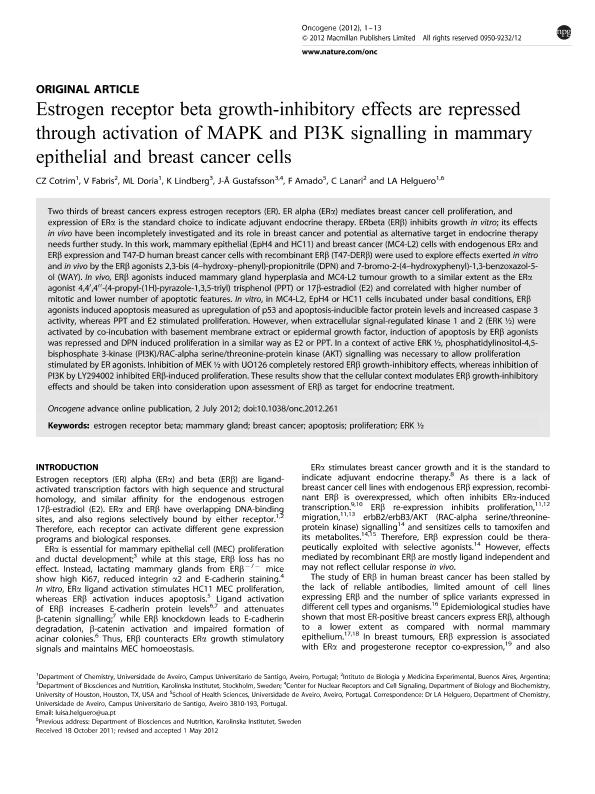Mostrar el registro sencillo del ítem
dc.contributor.author
Cotrim, C. Z.
dc.contributor.author
Fabris, Victoria Teresa

dc.contributor.author
Doria, M. L.
dc.contributor.author
Lindberg, K.
dc.contributor.author
Gustafsson, J. A.
dc.contributor.author
Amado, F.
dc.contributor.author
Lanari, Claudia Lee Malvina

dc.contributor.author
Helguero, L. A.
dc.date.available
2016-04-25T15:00:42Z
dc.date.issued
2013-05-09
dc.identifier.citation
Cotrim, C. Z.; Fabris, Victoria Teresa; Doria, M. L.; Lindberg, K.; Gustafsson, J. A.; et al.; Estrogen receptor beta growth inhibitory effects are repressed through activation of MAPK and PI3K signalling in mammary epithelial and breast cancer cells; Nature Publishing Group; Oncogene; 32; 19; 9-5-2013; 2390-2402
dc.identifier.issn
0950-9232
dc.identifier.uri
http://hdl.handle.net/11336/5358
dc.description.abstract
Two thirds of breast cancers express estrogen receptors (ER). ER alpha (ERa) mediates breast cancer cell proliferation, and expression of ERa is the standard choice to indicate adjuvant endocrine therapy. ERbeta (ERb) inhibits growth in vitro; its effects in vivo have been incompletely investigated and its role in breast cancer and potential as alternative target in endocrine therapy needs further study. In this work, mammary epithelial (EpH4 and HC11) and breast cancer (MC4-L2) cells with endogenous ERa and ERb expression and T47-D human breast cancer cells with recombinant ERb (T47-DERb) were used to explore effects exerted in vitro and in vivo by the ERb agonists 2,3-bis (4?hydroxy?phenyl)-propionitrile (DPN) and 7-bromo-2-(4?hydroxyphenyl)-1,3-benzoxazol-5-ol (WAY). In vivo, ERb agonists induced mammary gland hyperplasia and MC4-L2 tumour growth to a similar extent as the Era agonist 4,4´,4´´-(4-propyl-(1H)-pyrazole-1,3,5-triyl) trisphenol (PPT) or 17b-estradiol (E2) and correlated with higher number of mitotic and lower number of apoptotic features. In vitro, in MC4-L2, EpH4 or HC11 cells incubated under basal conditions, ERb agonists induced apoptosis measured as upregulation of p53 and apoptosis-inducible factor protein levels and increased caspase 3 activity, whereas PPT and E2 stimulated proliferation. However, when extracellular signal-regulated kinase 1 and 2 (ERK ½) were activated by co-incubation with basement membrane extract or epidermal growth factor, induction of apoptosis by ERb agonists was repressed and DPN induced proliferation in a similar way as E2 or PPT. In a context of active ERK ½, phosphatidylinositol-4,5-bisphosphate 3-kinase (PI3K)/RAC-alpha serine/threonine-protein kinase (AKT) signalling was necessary to allow proliferation stimulated by ER agonists. Inhibition of MEK ½ with UO126 completely restored ERb growth-inhibitory effects, whereas inhibition of PI3K by LY294002 inhibited ERb-induced proliferation. These results show that the cellular context modulates ERb growth-inhibitory effects and should be taken into consideration upon assessment of ERb as target for endocrine treatment.
dc.format
application/pdf
dc.language.iso
eng
dc.publisher
Nature Publishing Group

dc.rights
info:eu-repo/semantics/openAccess
dc.rights.uri
https://creativecommons.org/licenses/by-nc-sa/2.5/ar/
dc.subject
Estrogen Receptor Beta
dc.subject
Mammary Gland
dc.subject
Breast Cancer
dc.subject
Apoptosis
dc.subject
Proliferation
dc.subject
Erk 1/2
dc.subject.classification
Oncología

dc.subject.classification
Medicina Clínica

dc.subject.classification
CIENCIAS MÉDICAS Y DE LA SALUD

dc.title
Estrogen receptor beta growth inhibitory effects are repressed through activation of MAPK and PI3K signalling in mammary epithelial and breast cancer cells
dc.type
info:eu-repo/semantics/article
dc.type
info:ar-repo/semantics/artículo
dc.type
info:eu-repo/semantics/publishedVersion
dc.date.updated
2016-05-06 15:52:43.262787-03
dc.identifier.eissn
1476-5594
dc.journal.volume
32
dc.journal.number
19
dc.journal.pagination
2390-2402
dc.journal.pais
Reino Unido

dc.journal.ciudad
Basingstoke
dc.description.fil
Fil: Cotrim, C. Z.. Universidade de Aveiro; Portugal
dc.description.fil
Fil: Fabris, Victoria Teresa. Consejo Nacional de Investigaciones Científicas y Técnicas. Instituto de Biología y Medicina Experimental (i); Argentina
dc.description.fil
Fil: Doria, M. L.. Universidade de Aveiro; Portugal
dc.description.fil
Fil: Lindberg, K.. Karolinska Institutet; Suecia
dc.description.fil
Fil: Gustafsson, J. A.. Karolinska Institutet; Suecia. University Of Houston; Estados Unidos
dc.description.fil
Fil: Amado, F.. Universidade de Aveiro; Portugal
dc.description.fil
Fil: Lanari, Claudia Lee Malvina. Consejo Nacional de Investigaciones Científicas y Técnicas. Instituto de Biología y Medicina Experimental (i); Argentina
dc.description.fil
Fil: Helguero, L. A.. Universidade de Aveiro; Portugal
dc.journal.title
Oncogene

dc.relation.alternativeid
info:eu-repo/semantics/altIdentifier/url/http://www.nature.com/onc/journal/v32/n19/full/onc2012261a.html
dc.relation.alternativeid
info:eu-repo/semantics/altIdentifier/doi/10.1038/onc.2012.261
dc.relation.alternativeid
info:eu-repo/semantics/altIdentifier/doi/http://dx.doi.org/10.1038/onc.2012.261
Archivos asociados
